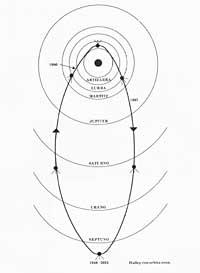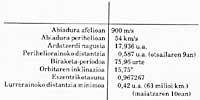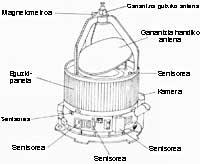With the arrival of comet HALLEY…
...A little history
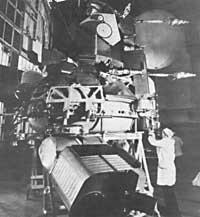
First confirmed mention of comet Halley in China. It is the one that appears in the annals of the year 239. Today we know with great precision the orbit of the comet Halley and those passed by the perihelion. Thanks to calculations made by Kiang. According to these calculations, the comet went through the perihelion on March 30 of that same year, so there is no doubt of its identity. Reliable references among Europeans are much later, although there are questionable references, some previous to those found in Chinese analysts.
However, those who made these references over many centuries did not know that the comet they saw had appeared before and had traveled around the Sun. British astronomer Edmund Halley (1656-1742) realized this based on his calculations after observing the comet in 1682.
In ancient civilizations comets were not considered to the Moon and to the height of the planets, were not considered as astronomical objects, or in cases where they were considered as such were not considered to adopt a periodic behavior as known as the rest. On the contrary, they considered that their apparitions were absolutely arbitrary and in the general were considered a sign of lamentable events.

Renaissance astronomers had the opportunity to see, largely neglecting prejudice. A study of comets was made and attempts were made to delineate their trajectories in some way. This work was not seriously uprooted E. Until Halley tried to obtain his equations by analyzing the trajectories of the comets observed until then by Newton using the law of gravity. Newton, by his laws, provided tools for calculating trajectories.
As we have said, E. This work was done for the first time by Halley, rejecting all the speculations made until then, demonstrating that the orbits of the comets were also elliptical. Halley himself, in 1682, was able to observe the comet data with previous works by other astronomers. In 1705 he published the news giving the route of the comet he saw in 1682 and saying that he would return in 1758. This prediction was fulfilled quite accurately, as the comet passed through perihelion on March 13, 1758.
Thereafter this comet is called Halley comet with a period of about 76 years. E. Halley observed in 1682 the trajectory of the comet comparing it with that of other astronomers that appeared in the previous centuries, with some of the views in 1456, 1531 and 1607, when he observed that the time intervals between those years were very similar, he discovered the periodicity of comet Halley.
Commenting on the characteristics of Halley
Before giving the singularities of the orbit it is important that the comet does not say that its orbit is performed in the direction in which all the planets and the Earth walk their orbits, but vice versa. In addition, it is interesting to mention the changes that experience the characteristics of the comet. The mass of Halley, like that of all comets, is much smaller than that of the planets. Therefore its influence becomes evident and the orbit undergoes changes during the comet's journey.
In addition to this, we must take into account another small effect that can modify the period. The side of the comet towards the sun heats up more than the other, so the emission of gases is greater than in that sense. This, coupled with the direction of the spin around itself, produces a slight slowdown or acceleration of the kite.
In general, the phenomenon described above is the cause of major changes. However, the influence of the planets on the elliptical orbit of Halley is not so great. To know these changes we will give the highest and lowest known value of the period of the comet Halley: the first, 79.1 years; the second, 74.9 years.
Since the characteristics of the orbit are variable, in Table 1 there are those of the last rotation that will pass through the perihelion on February 9.
Considerations on the nature of comets
Let us now put the comet on his long elliptical journey by studying the changes he suffers as he turns around and discovering some of the secrets he keeps from his personality.
We begin by worrying about the appearance of the comet when it is in the aphelion of its orbit. When they are in the aphelion, most comets are far from the Sun – in the case of Halley even further than Neptune – with all its components frozen. F.L. In Whipple's words, the kite would be a dirty snowball. Snow would be composed of water, carbon oxide ( IV), hydrocyanic acid and other frozen compounds, which are dirt, dust (silicates) interspersed in ice and the fraction of certain metals (see). The diameter of this ball we have described would be only one kilometer, so small and so far away would be invisible.
As the comet approaches the Sun it heats up and that is when the changes that give it its appearance begin. First, the ice on the top sublimates away from the comet body, while the collapsed gases drag the dust to the head. In the comet, two parts can now be distinguished: the core that remains frozen inside and the cloud formed by gases and dust around, which we will call commas.
This coma becomes larger as the comet approaches the Sun – millions of kilometers can be made – and thus becomes a spectacular comet. The light coming from Kometa comes from two different processes, one of fluorescence of gases that ionize the ultraviolet lights of the Sun and another of reflection of the dust fractions.
But we have not yet mentioned the most obvious particularity of comets: the tail. The tail is produced by the wind of the Sun. The fraction ejected from the sun and the pressure of radiation push the comma dust out, away from the Sun. Therefore, the tail is always extended in the opposite direction to the Sun. Therefore, when the comet starts to move away from the Sun the tail goes ahead. Although generally invisible, in addition to the dust tail, the ionized gas atoms that eject the random magnetic fields produced by electrons from the Sun form a new isasts.
When the comet moves away from the Sun and returns to the cold regions of the great planets, returning to the aphelion, it adopts its initial appearance. Most of the matter in the tail and coma is lost and the next round begins with less matter. It may be thought that the comet loses tons of matter at each turn and it is the process that will lead the comet to its death.
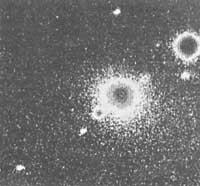

Therefore, due to the tours it gives, something sooner or later, depending on the distance that passes through the Sun, the comet would become dust, except in cases where its core is rock. In these cases the arqueta remains as an asteroid due to the gravity of the comet, performing at different speeds the same route as the maternal comet.
As Halley approaches, he gives more data to astronomers who have watched him. As a result of observations on Halley's composition, the comet appears to be composed almost entirely of ice. The Isaac Newton telescope, located in La Palma, has shown that in the coma of Halley there are groups CN,C 2 and C 3. However, according to astronomers, these will be only a small part of the dirty snow that forms the comet.
The observations of the French Nantay radioastronomers show hydroxyl groups. These hydroxyl groups are formed by decomposition of water under solar radiation. In addition, as Halley approaches the Sun, the signal emitted by the hydroxyl groups on the radiobuttons increases in intensity. This means that more and more ice is evaporating.

The Halley route has come to the same conclusion as scientists following through the IUE satellite (International Ultraviolet Explorer: Ultraviolet International Explorer). In addition, apart from the hydroxyl group they have been able to detect hydrogen atoms; the other product that forms together with hydroxyl in water decomposition. On the other hand, Halley has also been able to calculate the speed with which he consumes the ice of his core. At the end of September 1985, 100,000 tons of ice evaporated per day. Of course, this amount will skyrocket as you approach the Sun.
Why so much expectation about Halley?
Since comet Halley was last seen until today, scientists have been able to see many comets. Each year there are about thirty comets and forty-half, which follow those of a short period already known.
What then is the cause of the scandal that has arisen around Halley? Despite their abundance, the kites that have offered the opportunity to see them in recent years have been too small and have not offered the possibility of conducting an in-depth study. Nor did comet Kohout discovered in 1973 respond to initial expectations and no new comet information was obtained. However, the Halley kite is much larger and allows for wider analysis.
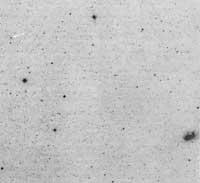
On the other hand, its orbit is well known, so time has been enough for the atrocities to occur that will meet it. The Soviet Union, Japan and Europe have organized coordinated missions. The Giotto probe, sent by ESA ( European SPACIAL Agency), will pass 500 km from the core of the comet by sending information until it deteriorates due to collisions with comma fractions.
According to the most accepted theory of the creation of the Solar System today, the Solar System arises from the contraction of a cloud of interstellar gas and dust. Given the high cloud, the contraction occurred with different intensity at different distances from the center. Logically, the biggest shrinkage occurred in the center of the cloud. There arose the Sun and the large fragments of slaughter that turned around created the planets, collected the matter of the area and were collisions between them.
The outer matter of the cloud, the influence of the gravity it endured and around the whole system, between one and two light years, remained a spherical shell. This shell would be precisely the one formed by the pencils we call comets. The first to propose the existence of this comet cloud was astronomer Jan H.Oort, so it is given its name: Oort Cloud. The comets we see would be those that have taken smaller orbits around the Sun as a result of the influence of some star in the area or its shocks.
All this is considered that the comets found in the Oort cloud will have compositions and singularities typical of the time in which the Solar System was formed, having not suffered a significant effect of attraction and solar radiation. Although comet Halley has been spinning around the Sun for a long time (it has completed 30 laps since it appeared in the Chinese annals), it is believed that it has not yet undergone major changes and that the information to be received from the Earth and the spaces can be of great help to confirm the theory of the origin of the Solar System.
Anecdotes about Halley
Traditionally society has considered the appearance of comets as an announcement of catastrophes or harmful events. The reason for this performance is ignorance of the nature of comets. As is known, ancient civilizations showed great curiosity about celestial phenomena, because they believed they were related to life on Earth. Thus, the early civilizations of history had quite well known the most common astronomical phenomena: the stars were considered fixed and, although the Sun, the Moon and the planets visible to the naked eye did not always have the same shape and position, they knew the periodicity of their movements.



As we have made clear, the comets did not do the same, because their apparitions did not apparently respect any norm. As we mentioned, this insecurity in the behavior of the comets made them think that these stars announced special events, normally harmful. As a result of this conviction, the apparitions of comets, and in particular of Halley, gave rise to special and surprising situations.
Halley's first known statement was made when he appeared in 684 in the Chronicles of the City of Nurenberg. It was also considered as an announcement of bad crops and plague.
One of the most recent appearances is that of 1066. That year the Nordic had to attack England and the arrival of the comet was considered a good sign for its purpose. And meet expectations. In the battle of Hasting the Normans triumphed and Harold II, king of the English, died. As a reminder of all these events a tapestry was made. This tapestry in Bayeux contains a new statement by Halley.
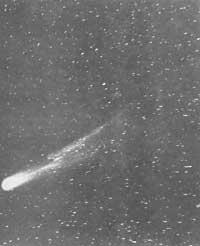
We also have another one that Giotto de Bondone did when he appeared in 1301. At that time he was painting the Chapel of Giotto Scrovegni. The Star of the Kings appearing in it is believed to be inspired by Halley. Therefore, the ESA has baptized as Giotto the above-mentioned space ship.
When the comet appeared in 1456, Europe feared the attacks of the Turks. Calixto III. The Pope sent Angelus to recite at noon, as until then was done in the morning and in the afternoon. Although Halley is not mentioned in the office that Calixto III released for the publication of this Order, it is considered that it had a great incidence.
In the following manifestations astronomers tried to analyze the comet and, as we have said before, in 1682 Halley observed all the conclusions presented.
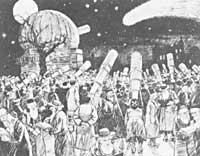
With the appearance of the last stage, in 1910, a great controversy arose around it. According to the calculations of the orbit, on May 18 of that year the Earth had to pass through the tail of the comet. By then, some of the ingredients of the kite were already known, among which were the most poisonous. This, together with the sensationalist information from the magazines of the time, caused great terror in the people, although astronomers tried to deny the misfortune of this fear by mentioning the low values of the pressure of the tail gases and the changes they would suffer when entering and heating up in the atmosphere. However, many were those who that night moved from cities to the mountains to see the "apocalypse." And because of fear of what was coming that day, there were also a few who committed suicide.



